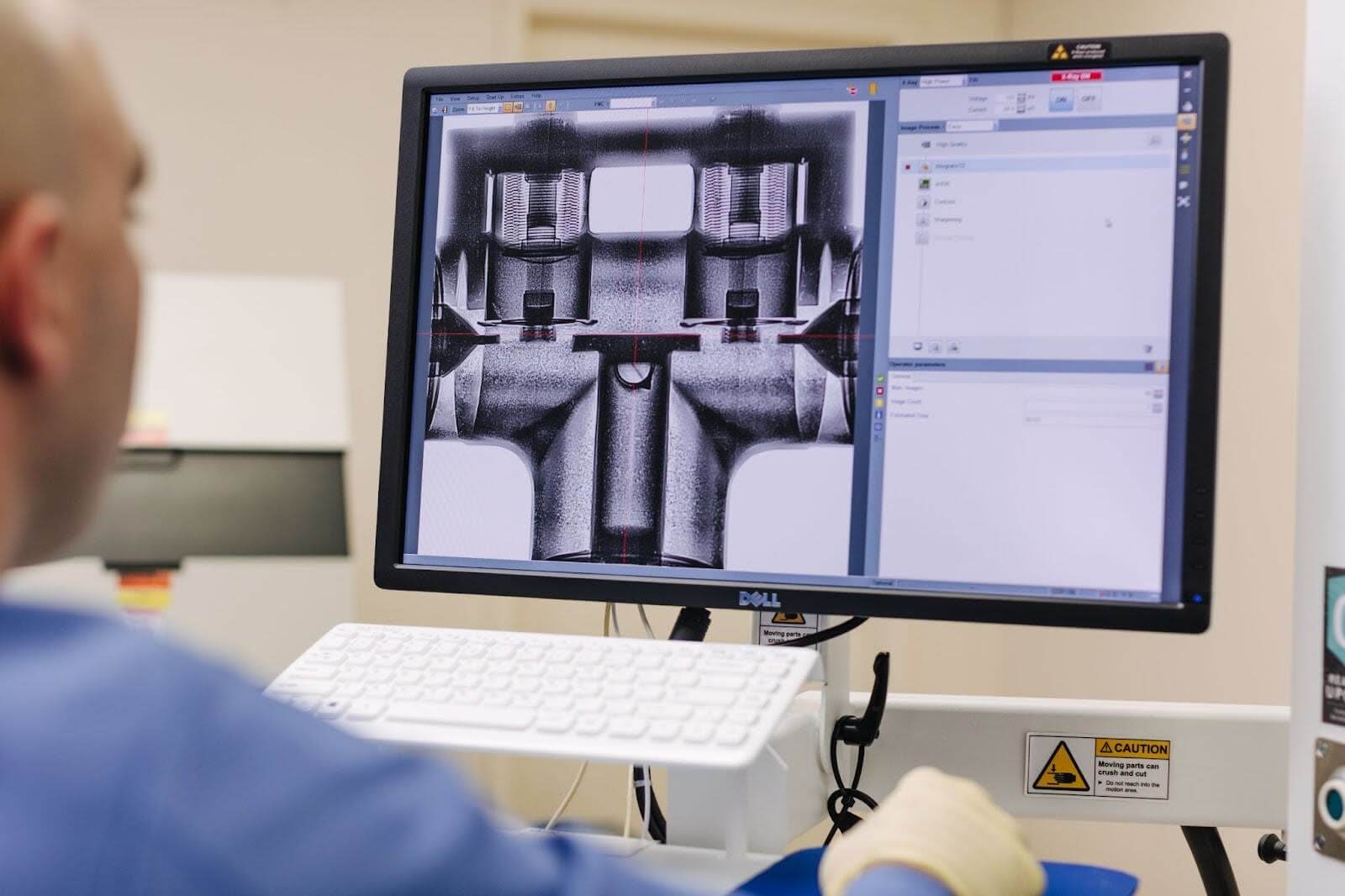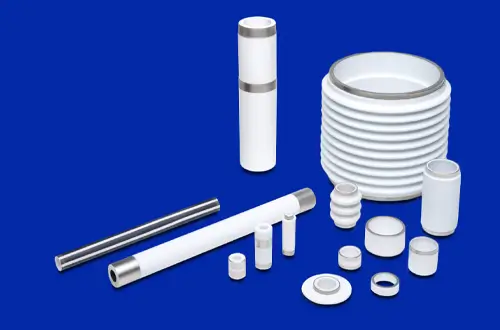Ceramic metallization has become a powerful driver of advanced solutions for the high-tech aerospace and medical industries, providing materials that can withstand extreme conditions while maintaining superior performance.
Marrying the superior properties of ceramics with the electrical and thermal conductivity of metals, this innovative process allows for the development of advanced components. These components are durable, resistant to extreme conditions and capable of performing complex functions essential for modern technology, making them ideal for a range of critical aerospace and medical applications.
Leaders in precision ceramic and sapphire components for military, medical, and aerospace applications, Elcon Precision has built a reputation for delivering higher-quality components and shorter lead times. With over five decades of industry experience, the Elcon team offers a full turn-key solution, from sourcing materials and engineering/design support to machining tooling and prototype testing.
This article breaks down the fundamentals of ceramic metallization and its key applications, advantages, challenges, and limitations.
The Fundamentals of Ceramic Metallization
Ceramic metallization is a process in which a layer of metal is deposited onto the substrate's ceramic surface to provide a wettable surface for subsequent brazing.
The process typically includes cleaning and preparing the ceramic surface, applying a layer of our metallization paint (molybdenum/manganese or molybdenum/manganese/tungsten blend) through needle painting, brush, spray, or screen-printing, and then sintering the coated ceramic to bond the metal layer permanently. The result is a component ready to be brazed into a hermetic assembly.
Unique Properties of Metallized Ceramics
- Thermal Resistance: Ceramics can withstand extremely high temperatures, making them ideal for high-temperature applications in aerospace and medical fields.
- Electrical Insulation: Ceramics provide excellent electrical insulation, essential for components that need to isolate electrical signals.
- Chemical Stability: The inert nature of ceramics ensures they remain stable and do not react adversely in harsh chemical environments.
- Enhanced Bond Strength and Robustness: This unique metallization formulation developed and produced entirely in-house enables a hermetic ceramic to metal bond in a brazed assembly.
At Elcon, our proven ceramic metallization process uses proprietary thick-film molybdenum/manganese and molybdenum/manganese/tungsten paints as the base layer on a ceramic substrate. Our expert team developed unique molybdenum-manganese (Mo-Mn) and tungsten(W) based metallization paints that enable a hermetic ceramic-to-metal bond in a brazed assembly.
To prevent oxidation and improve wettability after the metallization paint is sintered into the ceramic at high temperature, it is plated using either electroless or electrolytic plating or nickel oxide paint. Metallization and nickel thickness is measured using XRF technology to ensure desired thickness specifications are met.
We also offer plating on top of the Mo-Mn and Mo-Mn-W paints with the choice between silver and nickel (both with excellent electrical conductivity) and the highly corrosion-resistant and biocompatible gold.

Applications in the Aerospace Industry
Due to its ability to combine ceramics' high thermal stability and electrical insulation with metals' enhanced electrical conductivity and structural integrity, ceramic metallization has become an essential process for critical aerospace applications.
The innovative process ensures that critical aerospace components can perform reliably under extreme conditions, including high temperatures, pressures, and corrosive environments.
High Voltage, High Vacuum, and High-Pressure Environments
Ceramic metallization is crucial in the aerospace industry, particularly in high-voltage, high-vacuum, and high-pressure environments. Metalized ceramics are essential in jet engines and missile components, where they withstand extreme conditions while ensuring reliability and performance.
Electrical and Thermal Conductivity
Metallization significantly improves aerospace electronics by enhancing the electrical and thermal conductivity of ceramics, enabling efficient heat dissipation and stable electrical connections. Metalized ceramics in PCBs provide excellent electrical insulation and superior thermal conductivity, ensuring efficient heat management and reliable operation under extreme conditions. For capacitors, the metal layer improves electrical conductivity, allowing for better charge storage and discharge rates, which is crucial for the precise and high-speed demands of aerospace systems. The same applies to inductors, where metallization enhances the magnetic properties and overall efficiency of the component.
Corrosion Resistance
By providing increased corrosion resistance, metallization ensures long-term durability and reduces maintenance requirements for components exposed to harsh aerospace environments.

Applications in the Medical Industry
Ceramic metallization is critical for the development of high-performance electronic components that ensure the reliability and safety of medical devices.
In an industry where accuracy can directly impact patient outcomes, metalized ceramics provide the necessary precision and stability, especially in high vacuum and pressure applications, such as diagnostic imaging equipment and advanced surgical instruments. The robustness and consistent performance of these components are crucial in maintaining the functionality and safety of sophisticated medical electronics.
Medical device components often utilize gold plating for its biocompatibility and corrosion resistance, ensuring safe and durable performance in devices such as pacemakers, defibrillators, and implantable sensors. This metallization technique enhances the reliability and longevity of these life-saving devices.
The Key Industry Challenges Faced
As ceramic metallization becomes more popular, those searching for a trusted partner face numerous challenges.
Long lead times with ceramic metallization can delay the production and deployment of critical components in aerospace and medical applications. Poor quality metallization is another key issue with certain manufacturers, which can result in unreliable performance and premature failure of components, undermining the overall efficacy and safety of high-stakes technologies. Our XRF x-rays allow us to measure the metallization thickness, guaranteeing that customers receive parts with the correct specification.
The team at Elcon delivers precise solutions to these challenges, positioning them as a trusted partner for ceramic metallization in the aerospace and medical sectors. Collaborating with an array of approved ceramic vendors, we shorten the lead times for machining and offer better metallization lead times. We also offer blanket orders for customers with a time-sensitive demand for long-lead items.
Performance and reliability are at the core of everything we do, which is why we implement advanced quality control measures. We also provide comprehensive engineering support for design and material selection to ensure only the highest-quality components are delivered.
Advantages of Ceramic Metallization
Offering several advantages over traditional manufacturing methods, ceramic metallization has become an indispensable process in precision metal manufacturing. These advantages mainly come down to the versatility, customization, and specialization this powerful process provides.
Material Versatility and Customization
Engineers benefit from a wide range of metal choices for metallization, such as gold, silver, platinum, and nickel, allowing them to tailor properties to specific application needs. This versatility is particularly beneficial in enhancing the corrosion resistance of ceramics, which is crucial for applications exposed to harsh environments, like aerospace and medical industries.
Metallization also significantly improves the electrical and thermal conductivity of ceramics, enabling their use in high-performance electronic components where efficient heat dissipation and reliable electrical connections are essential. These combined benefits ensure that metalized ceramics deliver superior durability, performance, and reliability in demanding conditions.
Specialized Coatings
Additional plating options ensure that metalized ceramics can meet the diverse and demanding needs of advanced aerospace and medical technologies, providing enhanced performance, durability, and reliability.
Silver plating is highly valued for its exceptional electrical conductivity, making it ideal for components that demand efficient signal transmission and minimal electrical resistance. Besides its excellent electrical conductivity, nickel plating has excellent adhesion properties, making it an ideal choice for brazing applications requiring strong, reliable joints. The superior corrosion resistance and biocompatibility of gold plating make it an excellent choice for medical devices and components exposed to harsh environments.
Ceramic Metallization Limitations
Despite its numerous benefits, certain limitations need to be considered when choosing ceramic metallization.
For example, ceramic metallization presents certain geometric constraints that can affect the design and application of metalized components. The process of applying a metal layer onto a ceramic substrate often requires uniform coverage, which can be challenging on complex geometries with sharp edges, deep recesses, or intricate patterns. These geometric limitations can result in uneven coating thickness, leading to potential weak points in electrical connectivity or mechanical strength.
Maintaining adherence to the metal layer on curved or irregular surfaces can be also difficult, requiring the use of advanced techniques and meticulous quality control to ensure reliability.
Understanding these geometric constraints is essential for engineers to design components that maximize the benefits of ceramic metallization while ensuring consistent performance and durability.
Ceramic Metallization Experts: Elcon Precision’s Unique Capabilities
Continuously innovating and evolving its processes in coating techniques, material formulations/testing, and quality control, Elcon Precision is leading the way in ceramic metallization.
Offering a full turnkey solution, our end-to-end services cover everything from material sourcing right through to prototype testing.
Collaborating with an array of approved ceramic vendors, we shorten the machining LT of the ceramics and offer better metallization lead times as well. We also ensure the highest levels of performance and reliability through advanced quality control measures and comprehensive engineering support. In addition to our stringent quality standards, we are also AS9100D-certified, ISO 9001:2015-certified (certified by PRI), ITAR-registered, and RoHS-compliant - proving our commitment to industry-best quality.
Do you need a proven partner for your next ceramic metallization project?
Our team is here and ready to start talking, whatever your application may be.
Request a quote today to send us your thoughts and get your project moving.

